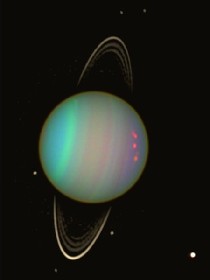The Planets - Uranus
Updated February 21, 2017 | Factmonster Staff 


Uranus is a greenish-blue planet, twice as far from the Sun as its neighbor Saturn. Uranus wasn't discovered until 1781. Its discoveror, William Herschel, named it Georgium Sidus (the Georgian star) after the English king, George III. Later its name was changed to Uranus, after an ancient Greek sky god, since all the other planets had been named after Roman and Greek gods.
- Size: 4 times larger than Earth in diameter
- Diameter: 32,193 miles (51,810 km)
- Surface: Little is known
- Atmosphere: Hydrogen, helium, and methane
- Temperature: uniform temperature of –353°F (–214°C)
- Rotation of its axis: 17 hours
- Rotation around the Sun: 30,685 days or 84 Earth years
- Your weight: Not known
- Distance from Earth: At the closest point, 1,607,000,000 miles
- Mean Distance from Sun: 1,783.98 million miles (2,870 million km)
- Satellites: 27
- Rings: 11
Fact Monster/Information Please® Database, © 2007 Pearson Education, Inc. All rights reserved.
See also:
